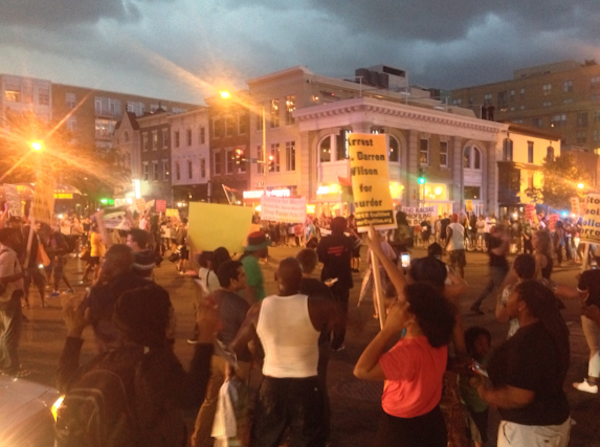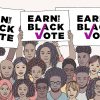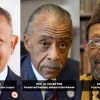
At 7 p.m. on Saturday night, “‘Hands up, don’t shoot!’ buttons, one dollar!” were the chants you heard outside of the 10th Street exit of the U Street/African-American Civil War Memorial/Cardozo. There, college students, random citizens, members of the National Black United Front (NBUF), the Party for Socialism and Liberation and the D.C. Statehood Green Party were gathering, ready to follow the lead of one man: Eugene Puryear.
It was the third time they’d done this since 18-year-old Michael Brown was shot and killed in Ferguson, Missouri. Their goal? To march the commercial corridors of the District and make the point that police brutality would not be accepted nationally or locally. The first two times, they went to H Street and then Chinatown. Now, it was Black Broadway.
At first, I was skeptical. There were probably 250 people there at its largest point. In a town like this, Small-scale marches usually don’t get you very far. But Puryear changed my mind.
Puryear is a D.C. based-activist who went to Howard University. The first time I ever saw him, he was at a candidate debate at the Sixth and I Street synagogue. Now, at 28, he’s running for an At-Large City Council seat. I came away thinking he was the smartest guy I heard speak all day.
But the situation in Ferguson definitely plays an important role here, as well, as he sees it. It’s easy to be outraged about what happened outside of St. Louis. But how does that apply to this city? Why march through local streets to tackle a national issue? The White House is just down the street, as some have demonstrated before. Unsurprisingly, east of the Anacostia is where this issue is most prevalent.
“I think it’s important from a D.C. standpoint, because we see even though MPD polices protests in a certain way, we still see the same sort of militarized aspect in a lot of Ward 7 and Ward 8 and all around the city,” he said before the march. Referring to the the practice of plain clothes police officers who take residents by surprise with frisks and searches by after pulling up in unmarked cars, he added: “Whether it’s the jump out boy phenomenon … whether it’s the issue of the 29 documented police killing since 2004, we don’t even really know. Because that’s just what’s listed publicly. Because some of them, like De’onte Rawlings have been left out.”
He added: “Is there a full accounting for these? We need, I think a full review of these sorts of things.”
On that matter, Metropolitan Police Department Chief Cathy Lanier said the current system locally is one of the best in the country. “Unlike some other jurisdictions, the United States Attorney’s Office completes a thorough independent review of each police shooting in Washington, D.C. and has done so for decades,” the chief said. “I think we are fortunate that Washington, DC is one of the most transparent jurisdictions in the nation.”
By 7:15, weather became a factor. The sky turned black, lighting was visible in the distance, with winds picking up drastically as soon as it was time to start walking. Taking to the streets in the westbound lanes of U Street, the chants started. They didn’t end until two hours later.
“Justice for? Michael Brown! Racist cops? Shut ‘em down,” they began. With a police escort, about 150 deep, they were off. Puryear led the chants. Switching them occasionally for effect. “Michael Brown, Emmett Till, how many black dudes will you kill?” were the words by the time the group got to 14th and U.
As the group circled the intersection, blocking all four road ways and effectively shutting it down, the effectiveness of marches became clear. Along the way, just watching the faces of people standing on the sidewalk was fascinating. Many took out the cellphones to take photos, some joined in the chants, even if for just a moment.
A march probably isn’t going to affect a ton of on the ground change, immediately. But here’s what it can do: turn a bad situation from a non-issue to an afterthought. Or from an afterthought to a current thought. It affects the subconscious bias of the average passerby, who might never have to deal with the scenario in their lives.
You go from saying, “Ferguson where?” to “Oh, man, St. Louis has some issues.” Or from “yeah, the police shot and killed a teenager in Southeast” to “actually, that’s seriously messed up.” It doesn’t take much, but it could affect how you think about yourself and your city the next time you make a decision about who you want to run this town and how.
Overall, the march proved to be a legit disruption. It was quite a sight to see people in their cars forced to wait and watch at some of the most well-traveled corners in Northwest while people like Salim Adofo, of the NBUF, rallied the crowd. It ranged from GWU college kids to older activists with gray hair. They braved the rain and did quite a bit of walking and shouting. It was impressive.
“ABC is gone. CNN is gone. So now it’s just us. And this is going to tell the truth. Are we out here, just because the media’s out here? Or are we out here for justice?” Adofo said, at the corner of 18th and Belmont, in the heart of Adams Morgan just before 9 o’clock. “Are we out here because we want a civilian review board, with subpoena power? … We want a full and complete review of all the police killings in the last 10 years in Washington, D.C. And we want a demilitarization of the police department. Because we tired of them jumpout boys. We tired of living in fear. Because see we not scared no more.”
Adofo, with his megaphone, black t-shirt and brown tactical pants might make a lot people assume “militant,” and all the other unnecessarily negative associations that come along with that. But between him and Puryear, everything was loud and forceful, not dangerous.
A sentiment that Patricia Patton portrayed before the group disbanded after shutting down 14th and Irving Streets NW in Columbia Heights.
“We’re here because we value life. We value our life. We value others’ lives. We’re here for love. Not for war. We’re here because we are people of love,” she said to the crowd around 9:30 p.m. “So understand that you’re here because you love yourself. You love your family and you’re fighting for love. Because that’s who you are. You are love and you are peace. … Anger does not defeat love. … Regardless of what color you are, you’re here because you love. Always remember that.”
The collective has hit the local corridors of D.C.’s business districts to make a point in the last month. They made noise, literally, and turned some heads. Puryear doesn’t think any one has been more effective than another. But the next one planned will certainly bring a completely different reaction. In October, expect to hear a lot more about their cause, because they’re planning to hit the most iconic shopping district in the city.















